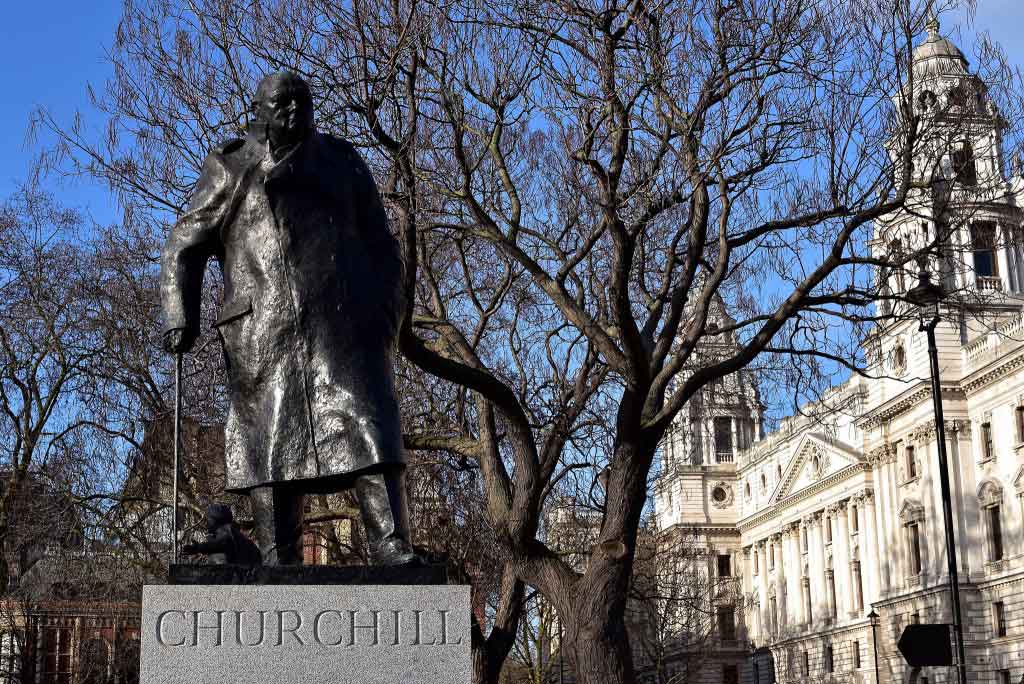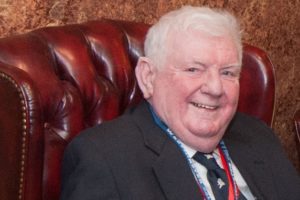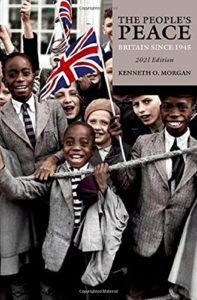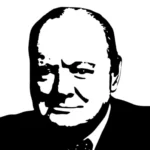Finest Hour 195
The PM and the Boffins
Churchill and His Scientists
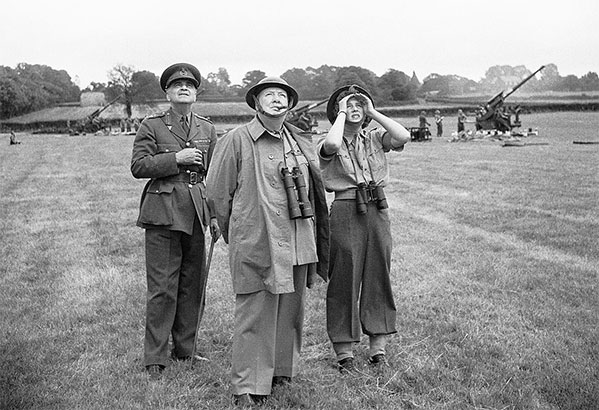
Gen. Tim Pile, WSC, and Mary Churchill, 1944
November 23, 2022
Finest Hour 195, First Quarter 2022
Page 08
By Andrew Nahum
Andrew Nahum is Keeper Emeritus of the Science Museum in London, where, in 2015, he led the exhibition “Churchill’s Scientists” in collaboration with Rachel Boon of the Science Museum and Lisa van Diem of Maastricht University. Andrew’s most recent book is Paths of Fire: The Gun and the World It Made (Reaktion Books, 2021).
On 15 September 1940, the turning point in the Battle of Britain, Prime Minister Winston Churchill visited the Royal Air Force fighter headquarters at Northolt. He had a theatrical view of the map table on which the radar reports were plotted battle and the defense was planned. Churchill’s account shows his acute and intuitive insight into science and invention:
All the ascendancy of the Hurricanes and Spitfires would have been fruitless but for this system…devised and built before the war…refined in constant action, and all was now fused together into a most elaborate instrument of war, the like of which existed nowhere in the world.1
Early Life
Churchill’s schoolwork had been patchy. Later, in the army, he read avidly to gain the knowledge he had missed. As well as history, his “empty hungry mind” consumed a physics primer, Darwin’s The Origin of Species, and the novels of H. G. Wells, which fascinated him. Wells became a friend but their closeness faded, perhaps as Churchill’s friendship with Frederick Lindemann developed.
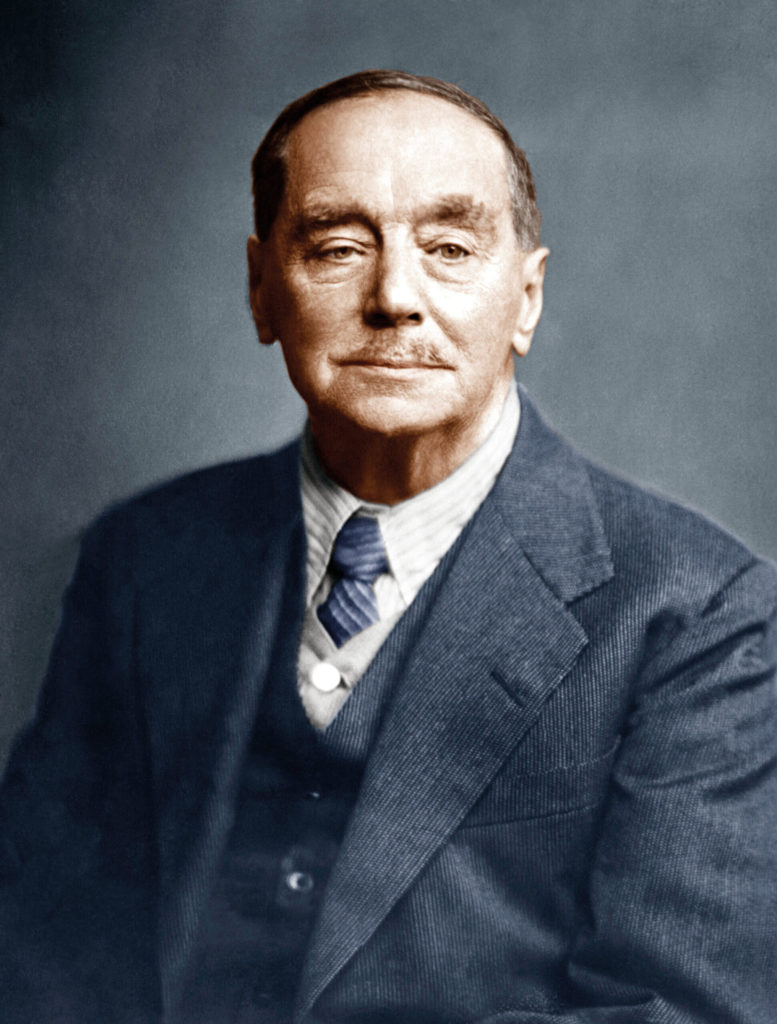
From the start, Lindemann helped with scientific advice, as Churchill, in his “wilderness years,” became one of Britain’s best-paid journalists. The two friends surely discussed the articles Churchill published between the two world wars under the titles “What Do You Know about Yourself?” “Are There Men on the Moon?” “The Racial Context of Nazism” and “Fifty Years Hence,” which not only predicted nuclear energy but also laboratory-grown meat.
But Churchill’s 1924 article “Shall We All Commit Suicide?” musing on a possible “atomic bomb” still derived from H. G. Wells, who coined the term. Churchill asked, “Might a bomb no bigger than an orange be found to possess a secret power to…blast a township at a stroke?” Churchill’s main argument, however, was his own: would the power of weapons run ahead of wisdom? “The story of the human race is War. Except for brief and precarious interludes, there has never been peace in the world.”2
Churchill’s Scientists
Britain, on the eve of the Second World War, was well endowed with research establishments. The armed forces had several and the Department of Scientific and Industrial Research (DSIR) administered establishments for civil research. But since Churchill had such a powerful scientific interest, and overarching control, we shall call all scientists in the war “Churchill’s Scientists.”
An intriguing feature of the science war was the selfmobilisation of scientists. It put a special stamp on the way the war was fought, but also on subsequent peacetime discoveries.
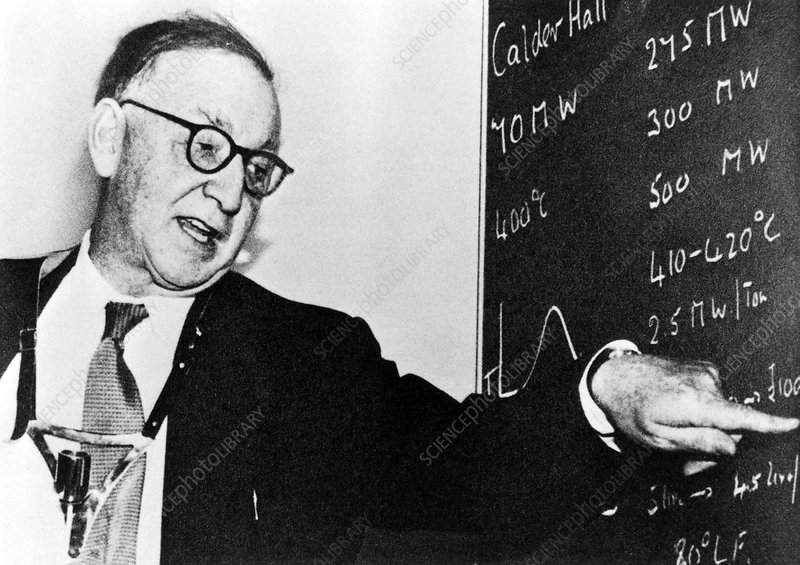
The first hint was “clubland at war.” John Cockcroft had “split the atom” in 1932 at the Cavendish Laboratory in Cambridge—a pre-eminent centre for nuclear research. Sometime in 1938, Sir Henry Tizard, the Air Ministry’s trusted scientific adviser and patron of radar, asked Cockcroft to lunch. “We met at the Athenaeum and there Tizard talked to me about new and secret devices we were building,” Cockcroft recalled. “These devices would be troublesome and would require a team of nurses. Would we, the Cavendish, undertake to come in and act as nursemaids, if and when war broke out?” This was a time when researchers mostly built their own apparatus and so could contribute to radar. Cockcroft later stated, “the whole school practically disappeared the first day of the war.”3
Radar and defence electronics was the centre of gravity of the scientific war, eventually employing some 3,500 high-grade scientists and technicians (see story p. 22). The work was a high intellectual challenge. For the physicist R. V. Jones, identifying and defeating German bomber navigation beams was “the best fun I ever had.”4
However, the “catch” of scientists for the radar programme was far wider than Cambridge. The physiologist A. V. Hill had brought science to anti-aircraft gunnery in the First World War. Now, as Secretary of the Royal Society, he launched a rational scheme, writing to all university administrators to list their scientific staff and students, past and present, with their specialties. “Hitler does not give one much time,” he urged.5 This information formed a “Central Register” listing the expertise of some 7000 scientists—a “precision instrument” in placing them.
Science in Action
Like Tizard, Hill was also active behind the scenes. In 1940 General “Tim” Pile, the head of Anti-Aircraft Command, admitted that anti-aircraft (AA) fire was not doing very well, and Hill introduced him to the physicist Patrick Blackett— eminent in nuclear physics and, earlier, a naval gunnery officer in the First World War.
Blackett’s team analysed anti-aircraft fire statistically: How densely should guns be concentrated? Where should they be placed? How could they smooth and average the imprecise plots from early radar to suit it for the gunnery computers that had been designed to use precise visual data? “Blackett’s circus” made remarkable improvements. Their methods helped found the new science of operational research. AA gunnery achieved some 20% of the 1,630 enemy aircraft brought down in the Battle of Britain.
As the threat from the air receded, the submarine threat grew. Britain’s survival depended on imports. The response was to take Blackett to Coastal Command. On hearing the news, General Pile at AntiAircraft Command reportedly lamented that they had stolen his “magician.”
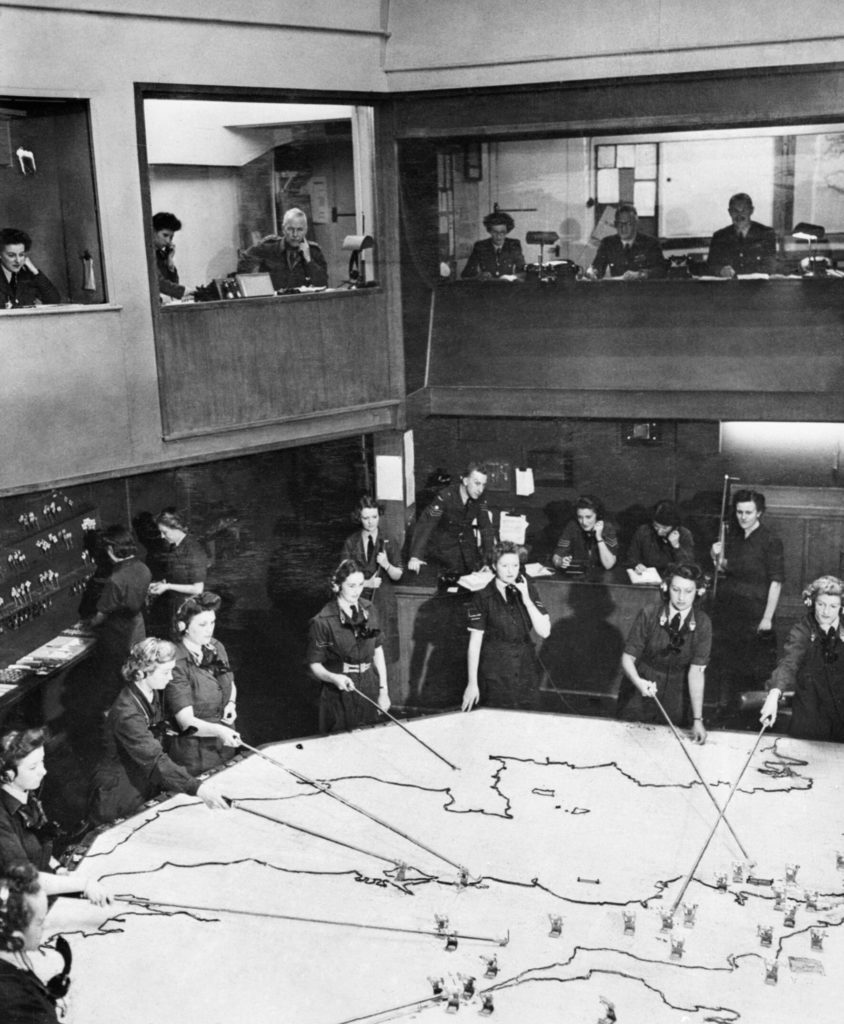
The anti-submarine warfare also needed statistical analysis and intuition. Should search aircraft fly if a proportion were unavailable? The prevailing view was to wait for a full fleet to sweep an area. Analysis showed the opposite: any available aircraft should fly to maximise number of hours over the U-boat routes. There were many problems: the best depth to set depth charge fuses, the best geometrical search pattern to fly, and much more.
During 1942 the losses from U-boat attacks in the North Atlantic reached 600,000 tons of shipping a month. But by the end of the year, as these defensive measures were refined, shipping losses fell to a third. The battle became so dangerous for U-boats that one was being sunk for every merchantman struck.
The Tots and Quots
While leaders of academia met with military planners in hushed clubs, younger scientists schemed over cheaper Soho dinners at the “Tots and Quots,” a dining club founded by the zoologist Solly Zuckerman: “All were destined for eminence in the scientific world and as the ‘tame magicians’ of the war…none was a fellow of the Royal Society; ‘in the end, all were.’”6
They felt that little was being done and published their proposals in a slim paperback, Science in War.7 Most became involved in operational research. Zuckerman went on to become “a professional student of destruction” as personal adviser to Air Marshall Tedder for the North African campaign and the subsequent landings in Italy. For D-Day and the invasion of Europe, Zuckerman devised his crucial “Transportation Plan” to paralyse the railway network before the Normandy landings.
Lindemann and S-Branch
It is impossible to discuss Churchill and science without mentioning Frederick Lindemann (Lord Cherwell), although Lindemann’s influence is described in much greater detail in the following article by Kevin Ruane. Lindemann was much more than a scientific adviser. When Churchill returned to government, as First Lord of the Admiralty in September 1939, he immediately set about creating a new Statistical Branch, known as “S-Branch,” at the Admiralty and headed by Lindemann.
Admiralty officials fought back: they had statisticians in all departments. Churchill was not deflected:
Surely the account you give of all these various disconnected Statistical Branches constitutes the case for a central body which should grip together all Admiralty statistics.…I want to know at the end of each week everything we have got… the progress of all vessels…all munitions affecting us,…our merchant tonnage, together with losses and numbers of every branch of the R.N.… How do you propose this want of mine should be met?8
The officials caved in and Lindemann was installed as head of S-Branch. When Churchill moved on to be become Prime Minister, Lindemann was transferred too.
Churchill did not want statistics massaged by government departments. He knew that they would build in safety estimates on food stocks, war materials, or production. But the war was fought with the tightest margins, so Churchill based his decisions on hard figures from S-Branch.
Lindemann’s colleague Roy Harrod recalled that he had “a special contempt for the bureaucrat and all his ways” and “a super-normal power of quick calculation…so he was able to take them by surprise and rout them.” His mission was to keep Churchill in good heart, protected from pessimistic officials “with all their gloomy forecasts.”9
The S-Branch burrowed down to the best figures they could find, cajoling or bypassing civil servants and finding powerful graphical ways to summarise this information for Churchill. These charts showed Churchill war production, the convoy struggle, fuel reserves, and even the national cheese stocks.10
These charts of S-Branch, combined with operational research, won the Battle of the Atlantic. Churchill wrote, “I was even more anxious about this battle than I had been about the glorious air fight called the Battle of Britain.…It did not take the form of flaring battles and glittering achievements. It manifested itself through statistics, diagrams, and curves, unknown to the nation, incomprehensible to the public.”11
Lindemann’s role, beyond science, is underscored in the appointments book for Chequers (the Prime Minister’s official country house in Buckinghamshire) listing guests.12 Lindemann attended almost every weekend. Usually, guests were the top British leaders, later joined by their American equivalents. But the “Prof” was there when only family were present. In the long nights, Churchill and Lindemann sat up until 3:00 a.m. discussing the war, or reading the next day’s papers. No ordinary scientific adviser would do that.
The Diaspora of Radar
One day, in the bleak postwar year of 1947, a truck pulled into the Telecommunications Research Establishment at Malvern—the main radar research post. Most wartime scientists and engineers had returned to their universities or companies. The vast stock of electronic components built up in the war years was now an embarrassment. A friendly call to Charles Oatley, former deputy director, and now back in Cambridge at the Cavendish Laboratory, had asked him to collect what he would like. Oatley certainly knew what he needed. He loaded up electronic components of all kinds and precious instruments like oscilloscopes. There was too much to count. They drove onto a weighbridge and signed a chit giving the tonnage.
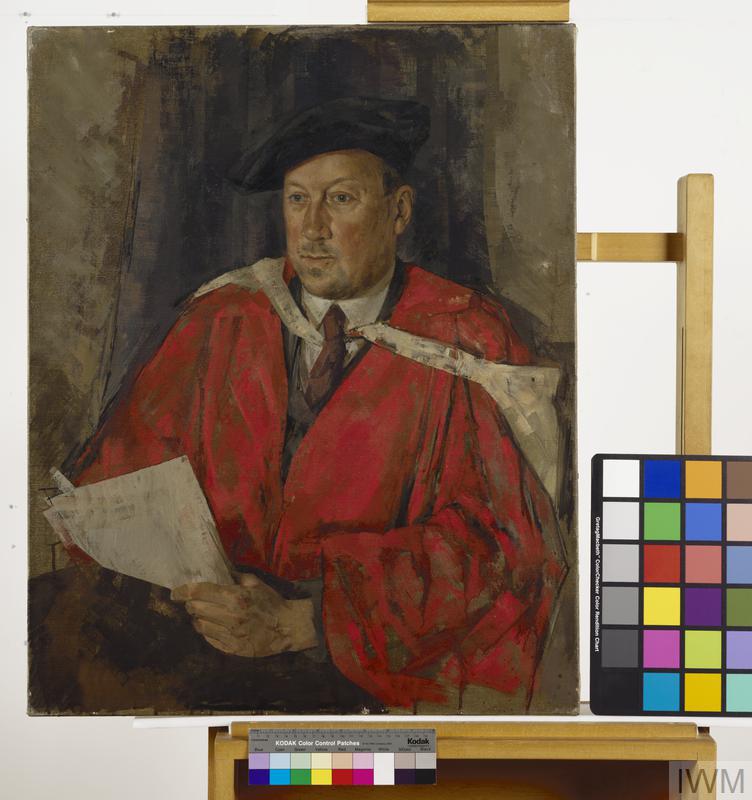
Back in Cambridge this haul sustained years of fundamental research, including Oatley’s own invention of the scanning electron microscope. Brian Pippard used it and his wartime microwave radar skill to explore superconductivity and low-temperature physics. Maurice Wilkes, also ex-radar, created EDSAC, the first Cambridge computer.
Oatley’s truck is a charming parable, but shows the transformatory effect of the science war. British science post-war had an extraordinary run—almost a new Golden Age— an uplift driven by scientists returning from radar work in the war with enhanced practical, electronic, and theoretical skills. They animated fields like astrophysics, neurophysiology, molecular biology, and more.
Pure science became more influential and better funded— and a chief scientist became a permanent feature of every post-war government. The post-war period was marked by outstanding achievements in fundamental science and in technology.
John Cockcroft’s perception was that in the war scientists “had got used to spending money in quite a big way. In fact, we never thought of money at all. In the war we got what we wanted for our research without any trouble at all. So money was not a limitation.” Moreover, “we [had] got used to engineering in a major way. None of us would [now] be afraid of building large machines…proton cyclotrons, things like that.”13
These scientists also helped establish the structure of scientific and academic organization nationally and in Europe. They ushered in an era of “big science,” for this wartime generation had become used to spending money in a big way and they had developed effective links with government.
The war also radically changed the attitude of governments toward supporting science. Politicians realised that it had been crucial in the war, while scientists themselves had more contacts. Many of them now knew influential civil servants and the corridors of power.
The ambitions and the confidence of the scientists had also changed. Many had directed or been part of large projects. Junior and middle-ranking scientists with little prior contact with the industrial world found themselves despatched to distant coastal sites around Britain, supervising and working with construction teams and electronics companies to install new radar sites.
Bernard Lovell recalled that “the question during the war was never ‘how much will it cost’ but can you do it and how soon can we have it.”14 Lovell had worked on radar for bombsights and submarine hunting but soon was building the world’s largest radio-telescope at Jodrell Bank outside Manchester.
Radio-astronomy was also important in the renewed science at Cambridge. Martin Ryle had spent the war in radar and radar countermeasures. Tony Hewish had installed radar jammers devised by Ryle into B-17 Superfortress aircraft, and recalled, “my time spent in the tails of bombers was not wasted.”15 Together they built a large aerial array in the countryside outside Cambridge and discovered many new astronomical features in the radio spectrum, including— with Jocelyn Bell Burnell—the unsuspected existence of pulsars.
One outcome of this cross-fertilisation was the subject of cybernetics, which then fostered the pursuit of artificial intelligence. Another was the new way of thinking about information. Electronic and communications defence had established it as something that could be quantified, with inherent rules. The idea of information as a linear stream in time, or along a tape, had taken hold.
The language of information became a metaphor informing biology—particularly the hunt for the structure of the gene. The rapid acceptance of Crick’s and Watson’s model for the structure of DNA, set out in their 1953 paper in Nature, was largely because their structure showed how the DNA strand could encode information and preserve it through cell divisions over many generations.
Moreover, the X-ray crystallography pictures that Crick and Watson used came from Rosalind Franklin, in the new biophysics department at Kings College, London, directed by John Randall, coinventor of magnetron—a key component in wartime radar. His department had been set up specifically with the goal of using wartime advances in electronics and instrumentation to solve biological problems.
Reflections on Science
As peace came in sight, Churchill looked ahead to a new era of science and, in a speech at Harvard in September 1943, foresaw that “The empires of the future will be empires of the mind.”16 He also returned to the themes he had explored in the 1920s: the immaturity of humankind to deal with its own discoveries. At MIT in 1949 he reflected, almost regretfully, on the growth of scientific knowledge:
This vast expansion was unhappily not accompanied by any noticeable advance in the stature of man, either in his mental facilities, or his moral character. His brain got no better, but it buzzed the more.…Science bestowed immense new powers on man, and, at the same time, created conditions which were largely beyond his comprehension and still more beyond his control.17
At the end, Churchill was still preoccupied with how humanity could advance science, but also control it. His last major speech to the House of Commons on 1 March 1955 returned to the theme and reflected ruefully that “there is no absolute defence against the hydrogen bomb.…I find it poignant to watch little children playing…and wonder what would lie before them if God wearies of us.” He followed with a realistic look at disarmament, before rallying to support an independent British deterrent “operating from a foundation of sober, calm and tireless vigilance.” He also made one of the first explicit expositions of the doctrine of mutually assured destruction (although he did not call it that) but suggested that the risk of war could be less when adversaries are capable of inflicting “quasimortal injury on the other.” We live, in a “hideous epoch” but the day could come when “fair play, love for one’s fellow men, respect for justice and freedom” might return.18
Endnotes
1. Winston Churchill, The Second World War, vol. II, Their Finest Hour (London: Cassell, 1949), pp. 293–94.
2. Paul K. Alkon, “‘Shall We All Commit Suicide?’ Churchill’s Scientific Imagination,” Part 1, The Churchill Project, Hillsdale College, 24 October, 2020, accessed at https:// winstonchurchill.hillsdale. edu/churchills-scientificimagination-2/
3. Sir John Cockcroft, interviewed by Charles Wiener, American Institute of Physics, accessed at https://www.aip.org/historyprograml,kk .,s/niels-bohrlibrary/oral-histories/4557, December 2021. See also Mark L. E. Oliphant and Lord Penney, “John Douglas Cockroft, 1897–1967,” Biographical Memoirs of Fellows of the Royal Society, vol. 14 (London: Royal Society, 1968), pp. 139–88.
4. J. M. Goodchild, R. V. Jones and the Birth of Scientific Intelligence (Ph.D. thesis, University of Exeter, 2013), p. 146. The words were used in a lecture that Jones gave to the Royal United Services Institute (RUSI) on 19 February 1949.
5. AVHL I, A. V. Hill papers, Churchill Archives Centre, Churchill College, Cambridge.
6. Solly Zuckerman, From Apes to Warlords (London: Hamish Hamilton, 1978), p. 393.
7. Anonymous, Science in War (London: Penguin, 1940).
8. WSC (initialled), minute of 8 September 1939, in Statistical Branch: formation of – as part of the First Lord’s personal staff, to collate all Admiralty statistics… to be known as “S” Branch. Professor F A Lindemann FRS; appointment of as head of “S” Branch and personal advisor on Scientific development to First Lord on Scientific Development, ADM 1/10459, The National Archives, Kew.
9. R. F. (Roy) Harrod, The Prof: A Personal Memoir of Lord Cherwell (London: Macmillan, 1959), pp. 179–217. See also David Edgerton, Britain’s War Machine (London: Allen Lane, 2011), pp. 99–112.
10. MACD, Sir Donald McDougall papers, Churchill Archives Centre.
11. Edgerton, pp. 105–06.
12 Churchill, Their Finest Hour, p. 529.
13. Interview with Sir John Cockcroft by Charles Weiner, Washington, D.C., March 28, 1967, http://www.aip. org/history/ohilist/4557.html accessed 03/07/2013
14. Bernard Lovell, Echoes of War: The Story of H2S Radar (London: Taylor and Francis, 1993), p. 261.
15. Anthony Hewish, conversation with the author, Churchill College, 2012.
16. Robert Rhodes James, ed., Winston S. Churchill: His Complete Speeches, vol. VII, 1943–1949 (New York: Chelsea House, 1974), p. 6826.
17. Ibid., p. 7804.
18. Robert Rhodes James, ed., Winston S. Churchill: His Complete Speeches, vol. VIII, 1950–1963 (New York: Chelsea House, 1974), p. 8633.
Subscribe
WANT MORE?
Get the Churchill Bulletin delivered to your inbox once a month.

